Lean Implementation: Last Planner System in Doha, Qatar Construction
VerifiedAdded on 2023/06/15
|15
|3542
|114
Case Study
AI Summary
This case study explores the practical implementation of lean principles and tools, specifically the Last Planner System (LPS), in construction projects in Doha, Qatar. Faced with increasing competition and the need for sustainable construction, companies in Doha adopted lean construction to maximize value and minimize waste. The study details how the LPS was applied to improve productivity, reduce costs, and enhance project completion times. The research methodology involved a positivist approach, formulating and testing hypotheses to demonstrate the positive impact of lean principles on construction projects. A survey questionnaire was used to gather data and identify critical success factors and barriers to LPS implementation. The findings indicate that the adoption of lean principles and the LPS has led to significant improvements in construction project performance in Doha, Qatar, with construction companies increasingly implementing these tools to deliver quality projects efficiently and sustainably. Desklib offers access to this assignment and many more to aid students in their studies.

Operations and Information Management-Practical Implementation of Lean Principles in
construction 1
Term Paper
Date:
3000 words
Name:
Institution:
construction 1
Term Paper
Date:
3000 words
Name:
Institution:
Paraphrase This Document
Need a fresh take? Get an instant paraphrase of this document with our AI Paraphraser
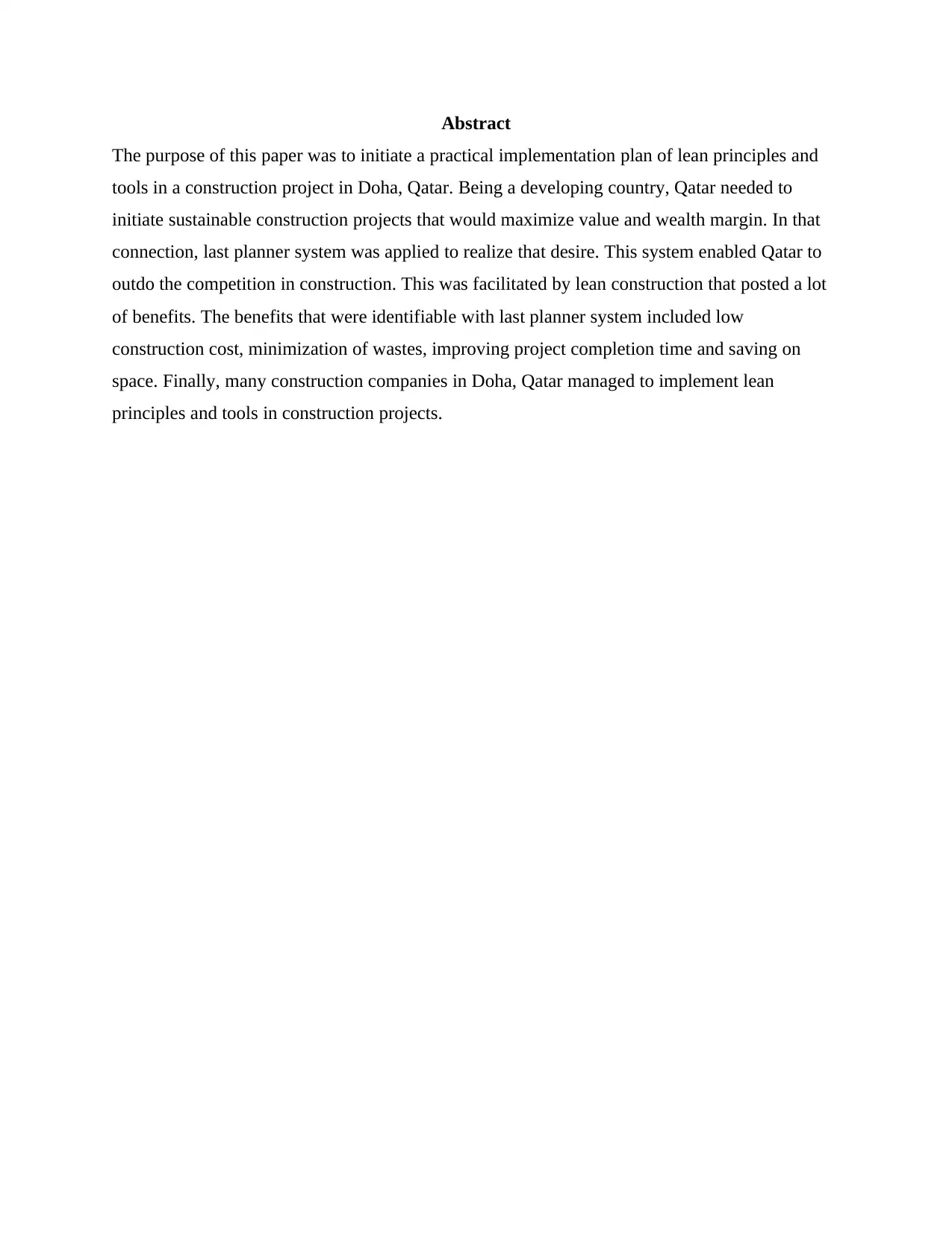
Abstract
The purpose of this paper was to initiate a practical implementation plan of lean principles and
tools in a construction project in Doha, Qatar. Being a developing country, Qatar needed to
initiate sustainable construction projects that would maximize value and wealth margin. In that
connection, last planner system was applied to realize that desire. This system enabled Qatar to
outdo the competition in construction. This was facilitated by lean construction that posted a lot
of benefits. The benefits that were identifiable with last planner system included low
construction cost, minimization of wastes, improving project completion time and saving on
space. Finally, many construction companies in Doha, Qatar managed to implement lean
principles and tools in construction projects.
The purpose of this paper was to initiate a practical implementation plan of lean principles and
tools in a construction project in Doha, Qatar. Being a developing country, Qatar needed to
initiate sustainable construction projects that would maximize value and wealth margin. In that
connection, last planner system was applied to realize that desire. This system enabled Qatar to
outdo the competition in construction. This was facilitated by lean construction that posted a lot
of benefits. The benefits that were identifiable with last planner system included low
construction cost, minimization of wastes, improving project completion time and saving on
space. Finally, many construction companies in Doha, Qatar managed to implement lean
principles and tools in construction projects.
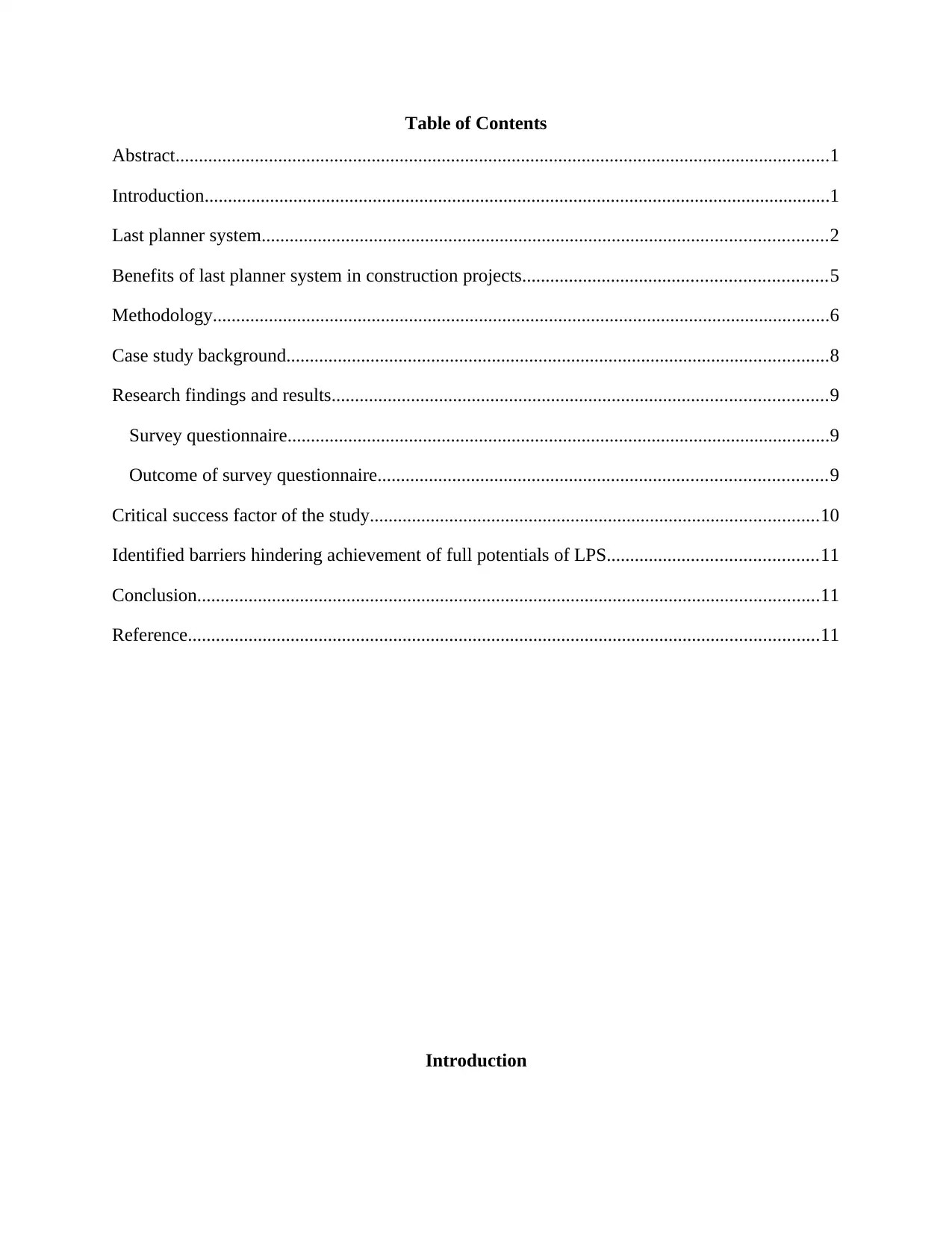
Table of Contents
Abstract............................................................................................................................................1
Introduction......................................................................................................................................1
Last planner system.........................................................................................................................2
Benefits of last planner system in construction projects.................................................................5
Methodology....................................................................................................................................6
Case study background....................................................................................................................8
Research findings and results..........................................................................................................9
Survey questionnaire....................................................................................................................9
Outcome of survey questionnaire................................................................................................9
Critical success factor of the study................................................................................................10
Identified barriers hindering achievement of full potentials of LPS.............................................11
Conclusion.....................................................................................................................................11
Reference.......................................................................................................................................11
Introduction
Abstract............................................................................................................................................1
Introduction......................................................................................................................................1
Last planner system.........................................................................................................................2
Benefits of last planner system in construction projects.................................................................5
Methodology....................................................................................................................................6
Case study background....................................................................................................................8
Research findings and results..........................................................................................................9
Survey questionnaire....................................................................................................................9
Outcome of survey questionnaire................................................................................................9
Critical success factor of the study................................................................................................10
Identified barriers hindering achievement of full potentials of LPS.............................................11
Conclusion.....................................................................................................................................11
Reference.......................................................................................................................................11
Introduction
⊘ This is a preview!⊘
Do you want full access?
Subscribe today to unlock all pages.

Trusted by 1+ million students worldwide
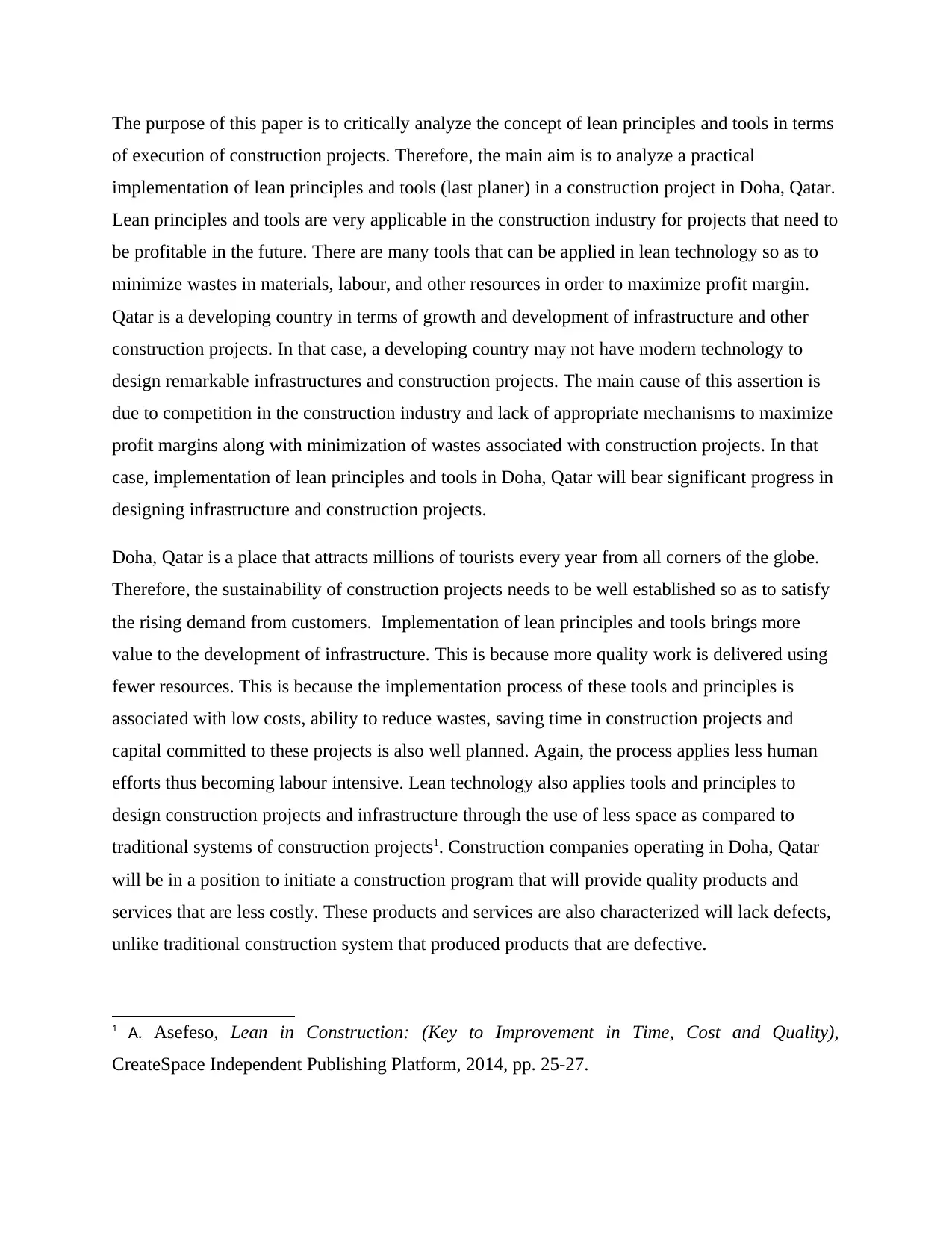
The purpose of this paper is to critically analyze the concept of lean principles and tools in terms
of execution of construction projects. Therefore, the main aim is to analyze a practical
implementation of lean principles and tools (last planer) in a construction project in Doha, Qatar.
Lean principles and tools are very applicable in the construction industry for projects that need to
be profitable in the future. There are many tools that can be applied in lean technology so as to
minimize wastes in materials, labour, and other resources in order to maximize profit margin.
Qatar is a developing country in terms of growth and development of infrastructure and other
construction projects. In that case, a developing country may not have modern technology to
design remarkable infrastructures and construction projects. The main cause of this assertion is
due to competition in the construction industry and lack of appropriate mechanisms to maximize
profit margins along with minimization of wastes associated with construction projects. In that
case, implementation of lean principles and tools in Doha, Qatar will bear significant progress in
designing infrastructure and construction projects.
Doha, Qatar is a place that attracts millions of tourists every year from all corners of the globe.
Therefore, the sustainability of construction projects needs to be well established so as to satisfy
the rising demand from customers. Implementation of lean principles and tools brings more
value to the development of infrastructure. This is because more quality work is delivered using
fewer resources. This is because the implementation process of these tools and principles is
associated with low costs, ability to reduce wastes, saving time in construction projects and
capital committed to these projects is also well planned. Again, the process applies less human
efforts thus becoming labour intensive. Lean technology also applies tools and principles to
design construction projects and infrastructure through the use of less space as compared to
traditional systems of construction projects1. Construction companies operating in Doha, Qatar
will be in a position to initiate a construction program that will provide quality products and
services that are less costly. These products and services are also characterized will lack defects,
unlike traditional construction system that produced products that are defective.
1 A. Asefeso, Lean in Construction: (Key to Improvement in Time, Cost and Quality),
CreateSpace Independent Publishing Platform, 2014, pp. 25-27.
of execution of construction projects. Therefore, the main aim is to analyze a practical
implementation of lean principles and tools (last planer) in a construction project in Doha, Qatar.
Lean principles and tools are very applicable in the construction industry for projects that need to
be profitable in the future. There are many tools that can be applied in lean technology so as to
minimize wastes in materials, labour, and other resources in order to maximize profit margin.
Qatar is a developing country in terms of growth and development of infrastructure and other
construction projects. In that case, a developing country may not have modern technology to
design remarkable infrastructures and construction projects. The main cause of this assertion is
due to competition in the construction industry and lack of appropriate mechanisms to maximize
profit margins along with minimization of wastes associated with construction projects. In that
case, implementation of lean principles and tools in Doha, Qatar will bear significant progress in
designing infrastructure and construction projects.
Doha, Qatar is a place that attracts millions of tourists every year from all corners of the globe.
Therefore, the sustainability of construction projects needs to be well established so as to satisfy
the rising demand from customers. Implementation of lean principles and tools brings more
value to the development of infrastructure. This is because more quality work is delivered using
fewer resources. This is because the implementation process of these tools and principles is
associated with low costs, ability to reduce wastes, saving time in construction projects and
capital committed to these projects is also well planned. Again, the process applies less human
efforts thus becoming labour intensive. Lean technology also applies tools and principles to
design construction projects and infrastructure through the use of less space as compared to
traditional systems of construction projects1. Construction companies operating in Doha, Qatar
will be in a position to initiate a construction program that will provide quality products and
services that are less costly. These products and services are also characterized will lack defects,
unlike traditional construction system that produced products that are defective.
1 A. Asefeso, Lean in Construction: (Key to Improvement in Time, Cost and Quality),
CreateSpace Independent Publishing Platform, 2014, pp. 25-27.
Paraphrase This Document
Need a fresh take? Get an instant paraphrase of this document with our AI Paraphraser
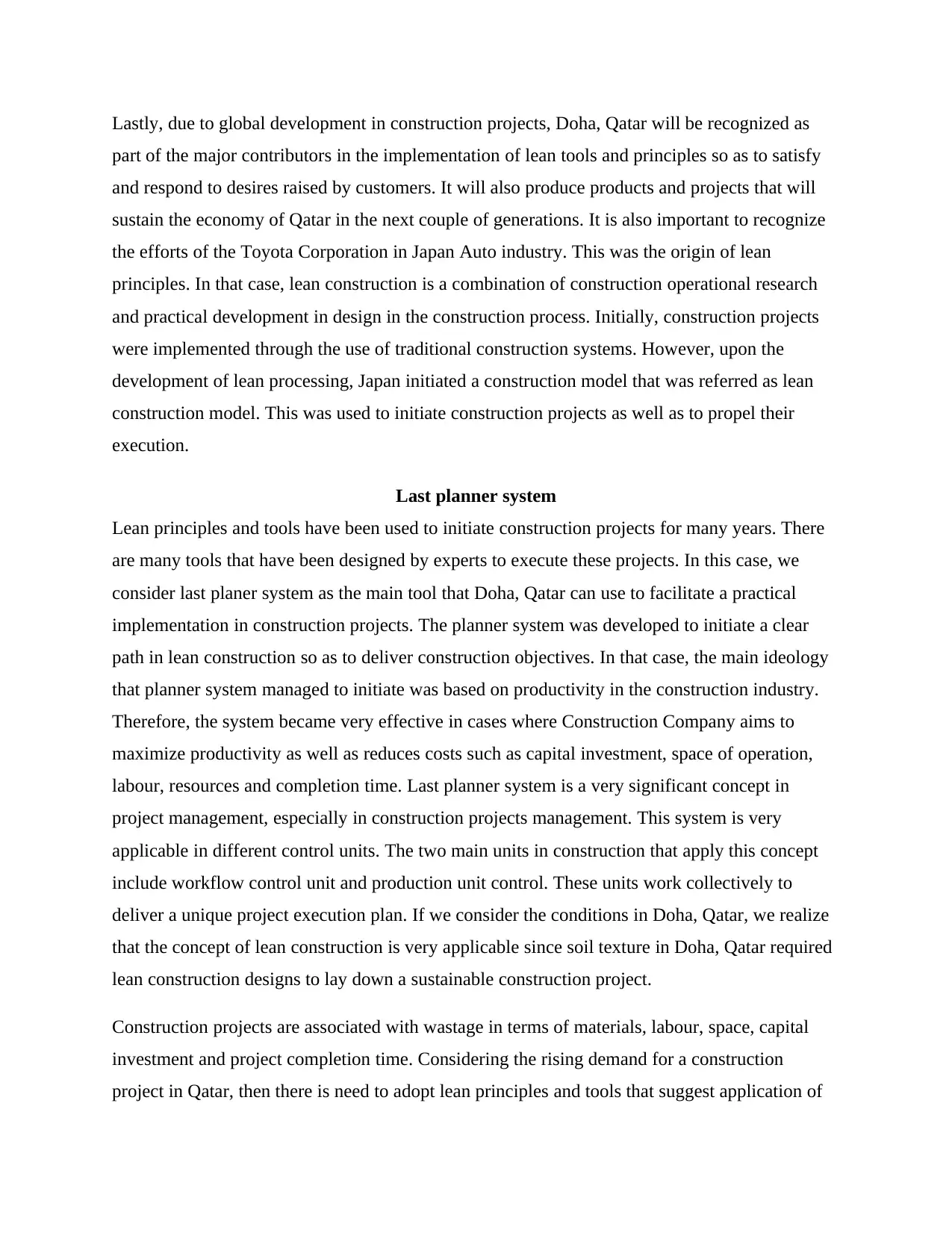
Lastly, due to global development in construction projects, Doha, Qatar will be recognized as
part of the major contributors in the implementation of lean tools and principles so as to satisfy
and respond to desires raised by customers. It will also produce products and projects that will
sustain the economy of Qatar in the next couple of generations. It is also important to recognize
the efforts of the Toyota Corporation in Japan Auto industry. This was the origin of lean
principles. In that case, lean construction is a combination of construction operational research
and practical development in design in the construction process. Initially, construction projects
were implemented through the use of traditional construction systems. However, upon the
development of lean processing, Japan initiated a construction model that was referred as lean
construction model. This was used to initiate construction projects as well as to propel their
execution.
Last planner system
Lean principles and tools have been used to initiate construction projects for many years. There
are many tools that have been designed by experts to execute these projects. In this case, we
consider last planer system as the main tool that Doha, Qatar can use to facilitate a practical
implementation in construction projects. The planner system was developed to initiate a clear
path in lean construction so as to deliver construction objectives. In that case, the main ideology
that planner system managed to initiate was based on productivity in the construction industry.
Therefore, the system became very effective in cases where Construction Company aims to
maximize productivity as well as reduces costs such as capital investment, space of operation,
labour, resources and completion time. Last planner system is a very significant concept in
project management, especially in construction projects management. This system is very
applicable in different control units. The two main units in construction that apply this concept
include workflow control unit and production unit control. These units work collectively to
deliver a unique project execution plan. If we consider the conditions in Doha, Qatar, we realize
that the concept of lean construction is very applicable since soil texture in Doha, Qatar required
lean construction designs to lay down a sustainable construction project.
Construction projects are associated with wastage in terms of materials, labour, space, capital
investment and project completion time. Considering the rising demand for a construction
project in Qatar, then there is need to adopt lean principles and tools that suggest application of
part of the major contributors in the implementation of lean tools and principles so as to satisfy
and respond to desires raised by customers. It will also produce products and projects that will
sustain the economy of Qatar in the next couple of generations. It is also important to recognize
the efforts of the Toyota Corporation in Japan Auto industry. This was the origin of lean
principles. In that case, lean construction is a combination of construction operational research
and practical development in design in the construction process. Initially, construction projects
were implemented through the use of traditional construction systems. However, upon the
development of lean processing, Japan initiated a construction model that was referred as lean
construction model. This was used to initiate construction projects as well as to propel their
execution.
Last planner system
Lean principles and tools have been used to initiate construction projects for many years. There
are many tools that have been designed by experts to execute these projects. In this case, we
consider last planer system as the main tool that Doha, Qatar can use to facilitate a practical
implementation in construction projects. The planner system was developed to initiate a clear
path in lean construction so as to deliver construction objectives. In that case, the main ideology
that planner system managed to initiate was based on productivity in the construction industry.
Therefore, the system became very effective in cases where Construction Company aims to
maximize productivity as well as reduces costs such as capital investment, space of operation,
labour, resources and completion time. Last planner system is a very significant concept in
project management, especially in construction projects management. This system is very
applicable in different control units. The two main units in construction that apply this concept
include workflow control unit and production unit control. These units work collectively to
deliver a unique project execution plan. If we consider the conditions in Doha, Qatar, we realize
that the concept of lean construction is very applicable since soil texture in Doha, Qatar required
lean construction designs to lay down a sustainable construction project.
Construction projects are associated with wastage in terms of materials, labour, space, capital
investment and project completion time. Considering the rising demand for a construction
project in Qatar, then there is need to adopt lean principles and tools that suggest application of
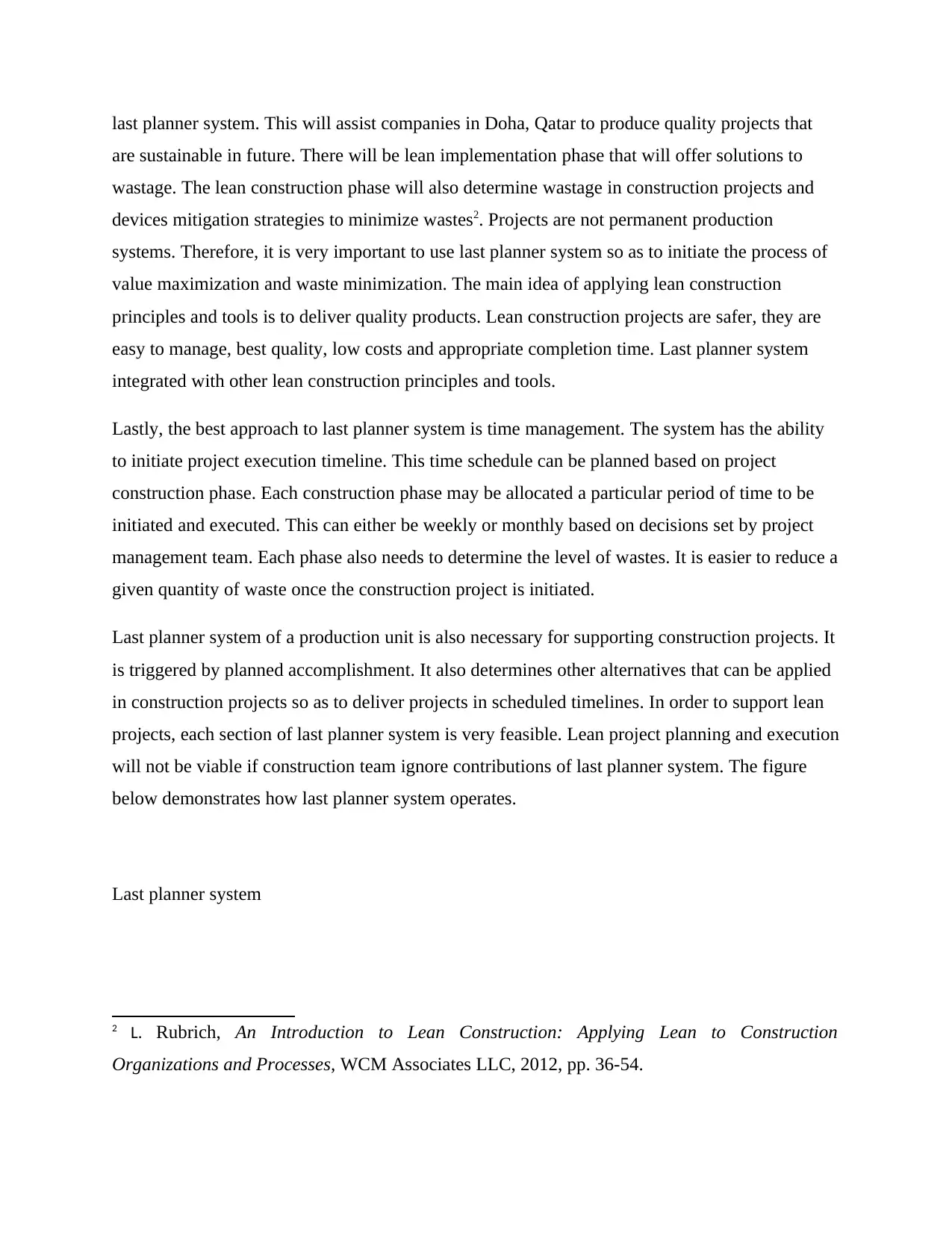
last planner system. This will assist companies in Doha, Qatar to produce quality projects that
are sustainable in future. There will be lean implementation phase that will offer solutions to
wastage. The lean construction phase will also determine wastage in construction projects and
devices mitigation strategies to minimize wastes2. Projects are not permanent production
systems. Therefore, it is very important to use last planner system so as to initiate the process of
value maximization and waste minimization. The main idea of applying lean construction
principles and tools is to deliver quality products. Lean construction projects are safer, they are
easy to manage, best quality, low costs and appropriate completion time. Last planner system
integrated with other lean construction principles and tools.
Lastly, the best approach to last planner system is time management. The system has the ability
to initiate project execution timeline. This time schedule can be planned based on project
construction phase. Each construction phase may be allocated a particular period of time to be
initiated and executed. This can either be weekly or monthly based on decisions set by project
management team. Each phase also needs to determine the level of wastes. It is easier to reduce a
given quantity of waste once the construction project is initiated.
Last planner system of a production unit is also necessary for supporting construction projects. It
is triggered by planned accomplishment. It also determines other alternatives that can be applied
in construction projects so as to deliver projects in scheduled timelines. In order to support lean
projects, each section of last planner system is very feasible. Lean project planning and execution
will not be viable if construction team ignore contributions of last planner system. The figure
below demonstrates how last planner system operates.
Last planner system
2 L. Rubrich, An Introduction to Lean Construction: Applying Lean to Construction
Organizations and Processes, WCM Associates LLC, 2012, pp. 36-54.
are sustainable in future. There will be lean implementation phase that will offer solutions to
wastage. The lean construction phase will also determine wastage in construction projects and
devices mitigation strategies to minimize wastes2. Projects are not permanent production
systems. Therefore, it is very important to use last planner system so as to initiate the process of
value maximization and waste minimization. The main idea of applying lean construction
principles and tools is to deliver quality products. Lean construction projects are safer, they are
easy to manage, best quality, low costs and appropriate completion time. Last planner system
integrated with other lean construction principles and tools.
Lastly, the best approach to last planner system is time management. The system has the ability
to initiate project execution timeline. This time schedule can be planned based on project
construction phase. Each construction phase may be allocated a particular period of time to be
initiated and executed. This can either be weekly or monthly based on decisions set by project
management team. Each phase also needs to determine the level of wastes. It is easier to reduce a
given quantity of waste once the construction project is initiated.
Last planner system of a production unit is also necessary for supporting construction projects. It
is triggered by planned accomplishment. It also determines other alternatives that can be applied
in construction projects so as to deliver projects in scheduled timelines. In order to support lean
projects, each section of last planner system is very feasible. Lean project planning and execution
will not be viable if construction team ignore contributions of last planner system. The figure
below demonstrates how last planner system operates.
Last planner system
2 L. Rubrich, An Introduction to Lean Construction: Applying Lean to Construction
Organizations and Processes, WCM Associates LLC, 2012, pp. 36-54.
⊘ This is a preview!⊘
Do you want full access?
Subscribe today to unlock all pages.

Trusted by 1+ million students worldwide
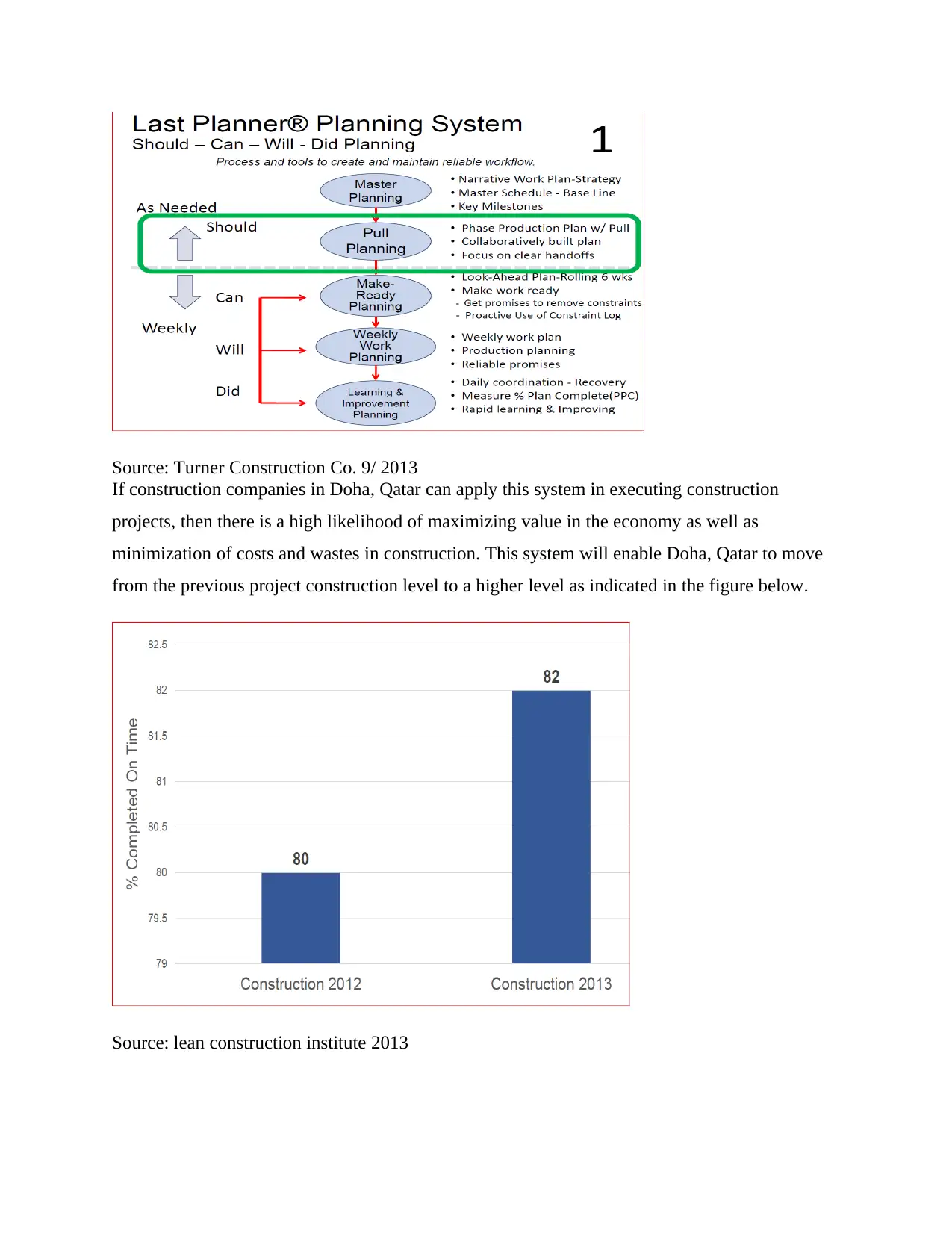
Source: Turner Construction Co. 9/ 2013
If construction companies in Doha, Qatar can apply this system in executing construction
projects, then there is a high likelihood of maximizing value in the economy as well as
minimization of costs and wastes in construction. This system will enable Doha, Qatar to move
from the previous project construction level to a higher level as indicated in the figure below.
Source: lean construction institute 2013
If construction companies in Doha, Qatar can apply this system in executing construction
projects, then there is a high likelihood of maximizing value in the economy as well as
minimization of costs and wastes in construction. This system will enable Doha, Qatar to move
from the previous project construction level to a higher level as indicated in the figure below.
Source: lean construction institute 2013
Paraphrase This Document
Need a fresh take? Get an instant paraphrase of this document with our AI Paraphraser
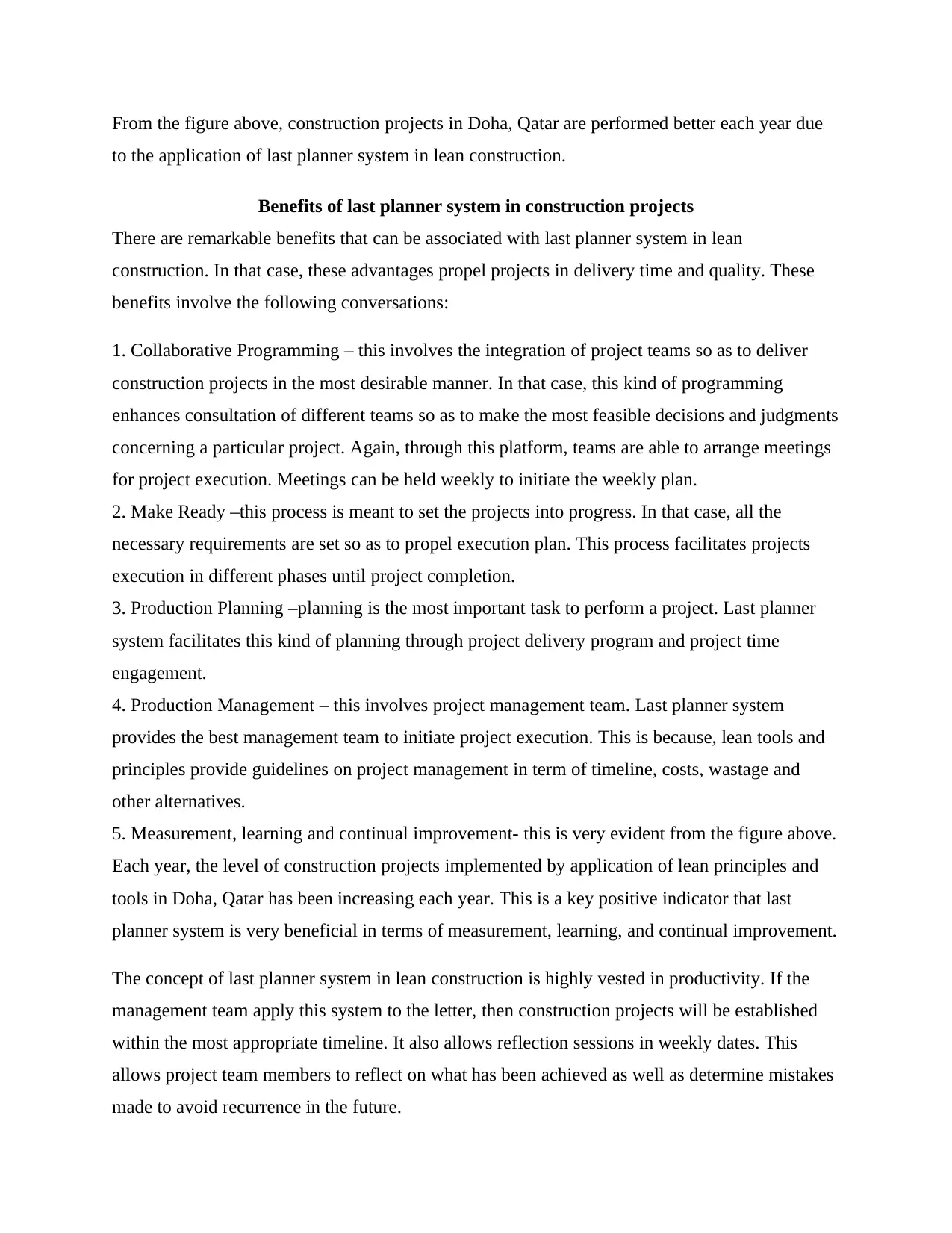
From the figure above, construction projects in Doha, Qatar are performed better each year due
to the application of last planner system in lean construction.
Benefits of last planner system in construction projects
There are remarkable benefits that can be associated with last planner system in lean
construction. In that case, these advantages propel projects in delivery time and quality. These
benefits involve the following conversations:
1. Collaborative Programming – this involves the integration of project teams so as to deliver
construction projects in the most desirable manner. In that case, this kind of programming
enhances consultation of different teams so as to make the most feasible decisions and judgments
concerning a particular project. Again, through this platform, teams are able to arrange meetings
for project execution. Meetings can be held weekly to initiate the weekly plan.
2. Make Ready –this process is meant to set the projects into progress. In that case, all the
necessary requirements are set so as to propel execution plan. This process facilitates projects
execution in different phases until project completion.
3. Production Planning –planning is the most important task to perform a project. Last planner
system facilitates this kind of planning through project delivery program and project time
engagement.
4. Production Management – this involves project management team. Last planner system
provides the best management team to initiate project execution. This is because, lean tools and
principles provide guidelines on project management in term of timeline, costs, wastage and
other alternatives.
5. Measurement, learning and continual improvement- this is very evident from the figure above.
Each year, the level of construction projects implemented by application of lean principles and
tools in Doha, Qatar has been increasing each year. This is a key positive indicator that last
planner system is very beneficial in terms of measurement, learning, and continual improvement.
The concept of last planner system in lean construction is highly vested in productivity. If the
management team apply this system to the letter, then construction projects will be established
within the most appropriate timeline. It also allows reflection sessions in weekly dates. This
allows project team members to reflect on what has been achieved as well as determine mistakes
made to avoid recurrence in the future.
to the application of last planner system in lean construction.
Benefits of last planner system in construction projects
There are remarkable benefits that can be associated with last planner system in lean
construction. In that case, these advantages propel projects in delivery time and quality. These
benefits involve the following conversations:
1. Collaborative Programming – this involves the integration of project teams so as to deliver
construction projects in the most desirable manner. In that case, this kind of programming
enhances consultation of different teams so as to make the most feasible decisions and judgments
concerning a particular project. Again, through this platform, teams are able to arrange meetings
for project execution. Meetings can be held weekly to initiate the weekly plan.
2. Make Ready –this process is meant to set the projects into progress. In that case, all the
necessary requirements are set so as to propel execution plan. This process facilitates projects
execution in different phases until project completion.
3. Production Planning –planning is the most important task to perform a project. Last planner
system facilitates this kind of planning through project delivery program and project time
engagement.
4. Production Management – this involves project management team. Last planner system
provides the best management team to initiate project execution. This is because, lean tools and
principles provide guidelines on project management in term of timeline, costs, wastage and
other alternatives.
5. Measurement, learning and continual improvement- this is very evident from the figure above.
Each year, the level of construction projects implemented by application of lean principles and
tools in Doha, Qatar has been increasing each year. This is a key positive indicator that last
planner system is very beneficial in terms of measurement, learning, and continual improvement.
The concept of last planner system in lean construction is highly vested in productivity. If the
management team apply this system to the letter, then construction projects will be established
within the most appropriate timeline. It also allows reflection sessions in weekly dates. This
allows project team members to reflect on what has been achieved as well as determine mistakes
made to avoid recurrence in the future.
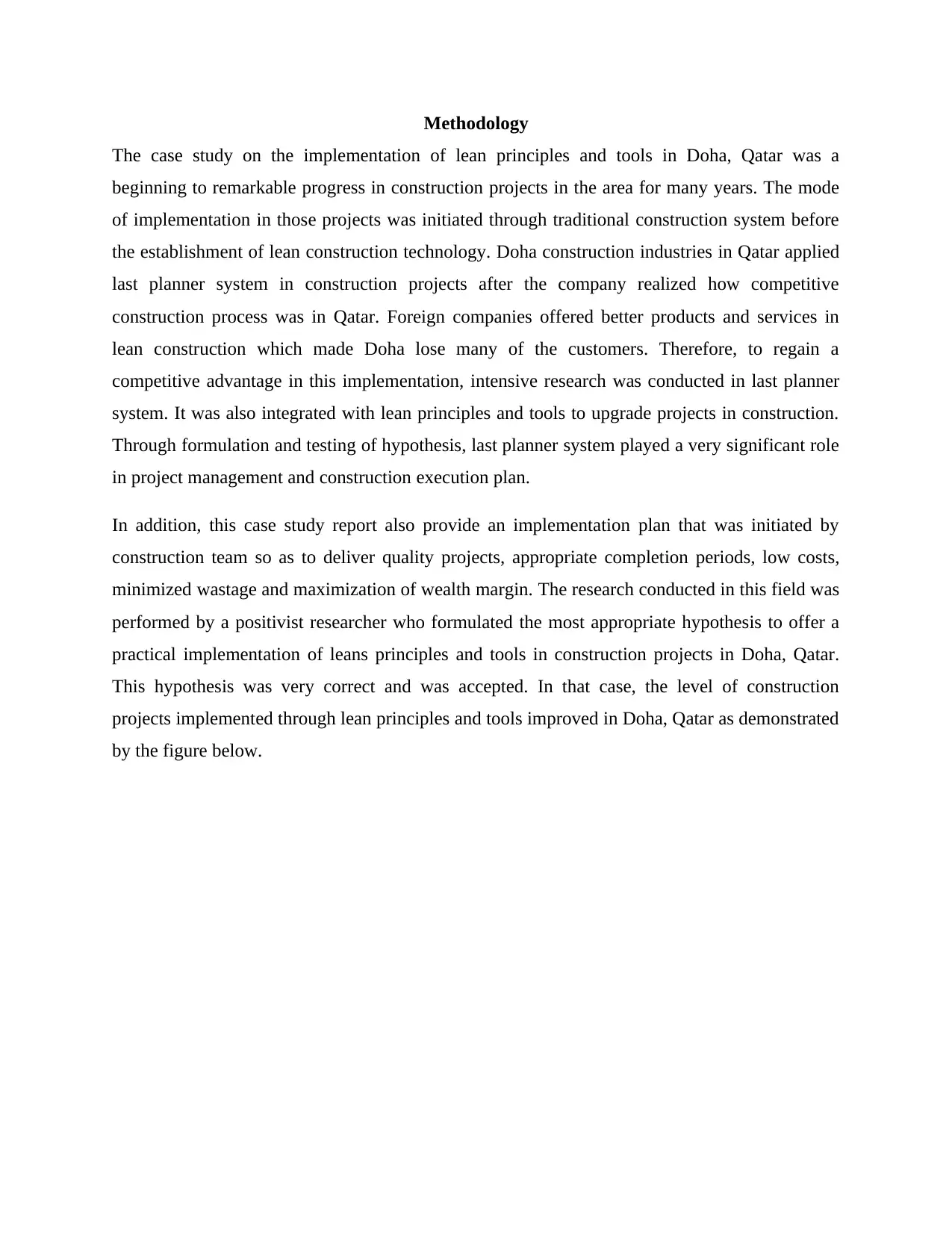
Methodology
The case study on the implementation of lean principles and tools in Doha, Qatar was a
beginning to remarkable progress in construction projects in the area for many years. The mode
of implementation in those projects was initiated through traditional construction system before
the establishment of lean construction technology. Doha construction industries in Qatar applied
last planner system in construction projects after the company realized how competitive
construction process was in Qatar. Foreign companies offered better products and services in
lean construction which made Doha lose many of the customers. Therefore, to regain a
competitive advantage in this implementation, intensive research was conducted in last planner
system. It was also integrated with lean principles and tools to upgrade projects in construction.
Through formulation and testing of hypothesis, last planner system played a very significant role
in project management and construction execution plan.
In addition, this case study report also provide an implementation plan that was initiated by
construction team so as to deliver quality projects, appropriate completion periods, low costs,
minimized wastage and maximization of wealth margin. The research conducted in this field was
performed by a positivist researcher who formulated the most appropriate hypothesis to offer a
practical implementation of leans principles and tools in construction projects in Doha, Qatar.
This hypothesis was very correct and was accepted. In that case, the level of construction
projects implemented through lean principles and tools improved in Doha, Qatar as demonstrated
by the figure below.
The case study on the implementation of lean principles and tools in Doha, Qatar was a
beginning to remarkable progress in construction projects in the area for many years. The mode
of implementation in those projects was initiated through traditional construction system before
the establishment of lean construction technology. Doha construction industries in Qatar applied
last planner system in construction projects after the company realized how competitive
construction process was in Qatar. Foreign companies offered better products and services in
lean construction which made Doha lose many of the customers. Therefore, to regain a
competitive advantage in this implementation, intensive research was conducted in last planner
system. It was also integrated with lean principles and tools to upgrade projects in construction.
Through formulation and testing of hypothesis, last planner system played a very significant role
in project management and construction execution plan.
In addition, this case study report also provide an implementation plan that was initiated by
construction team so as to deliver quality projects, appropriate completion periods, low costs,
minimized wastage and maximization of wealth margin. The research conducted in this field was
performed by a positivist researcher who formulated the most appropriate hypothesis to offer a
practical implementation of leans principles and tools in construction projects in Doha, Qatar.
This hypothesis was very correct and was accepted. In that case, the level of construction
projects implemented through lean principles and tools improved in Doha, Qatar as demonstrated
by the figure below.
⊘ This is a preview!⊘
Do you want full access?
Subscribe today to unlock all pages.

Trusted by 1+ million students worldwide
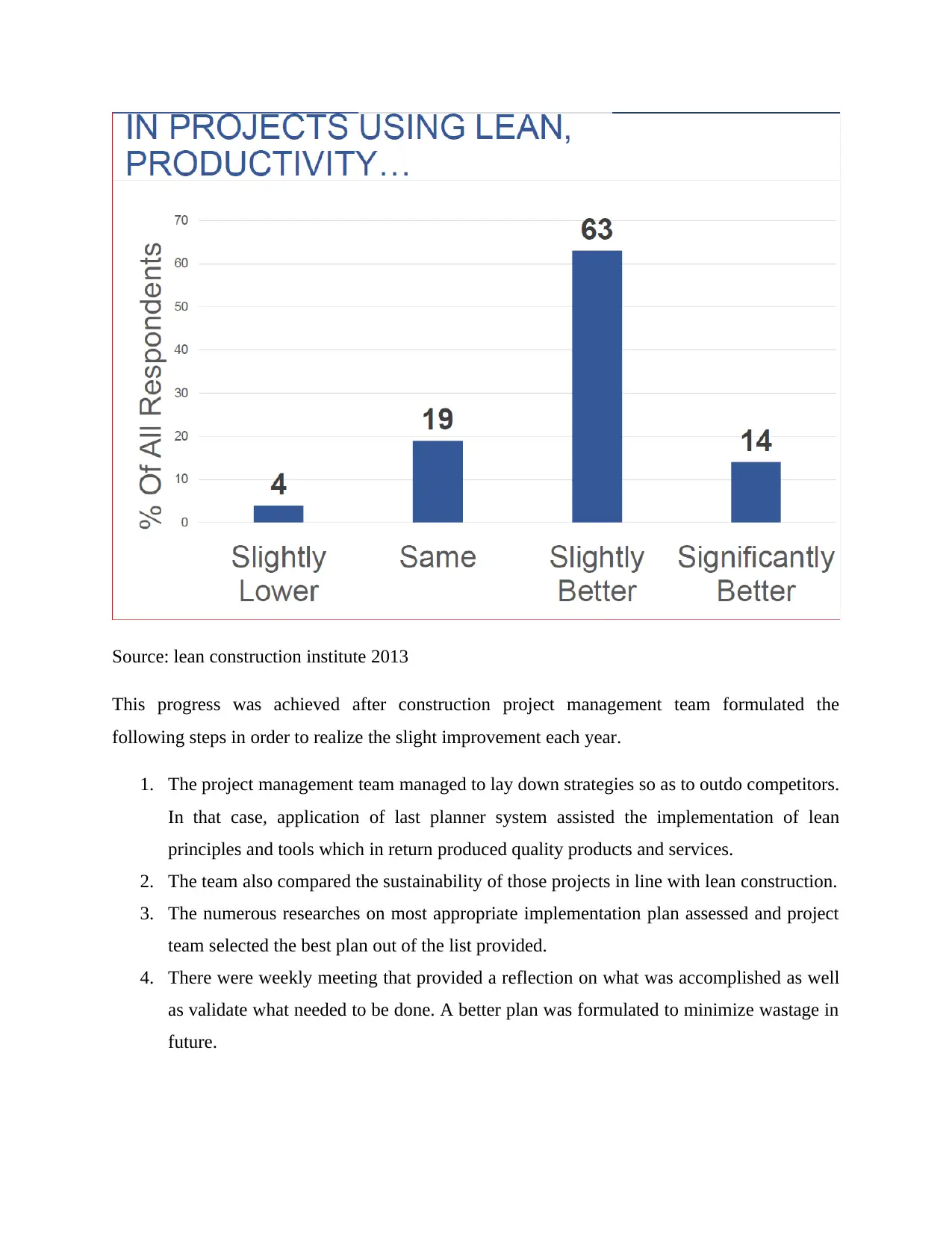
Source: lean construction institute 2013
This progress was achieved after construction project management team formulated the
following steps in order to realize the slight improvement each year.
1. The project management team managed to lay down strategies so as to outdo competitors.
In that case, application of last planner system assisted the implementation of lean
principles and tools which in return produced quality products and services.
2. The team also compared the sustainability of those projects in line with lean construction.
3. The numerous researches on most appropriate implementation plan assessed and project
team selected the best plan out of the list provided.
4. There were weekly meeting that provided a reflection on what was accomplished as well
as validate what needed to be done. A better plan was formulated to minimize wastage in
future.
This progress was achieved after construction project management team formulated the
following steps in order to realize the slight improvement each year.
1. The project management team managed to lay down strategies so as to outdo competitors.
In that case, application of last planner system assisted the implementation of lean
principles and tools which in return produced quality products and services.
2. The team also compared the sustainability of those projects in line with lean construction.
3. The numerous researches on most appropriate implementation plan assessed and project
team selected the best plan out of the list provided.
4. There were weekly meeting that provided a reflection on what was accomplished as well
as validate what needed to be done. A better plan was formulated to minimize wastage in
future.
Paraphrase This Document
Need a fresh take? Get an instant paraphrase of this document with our AI Paraphraser
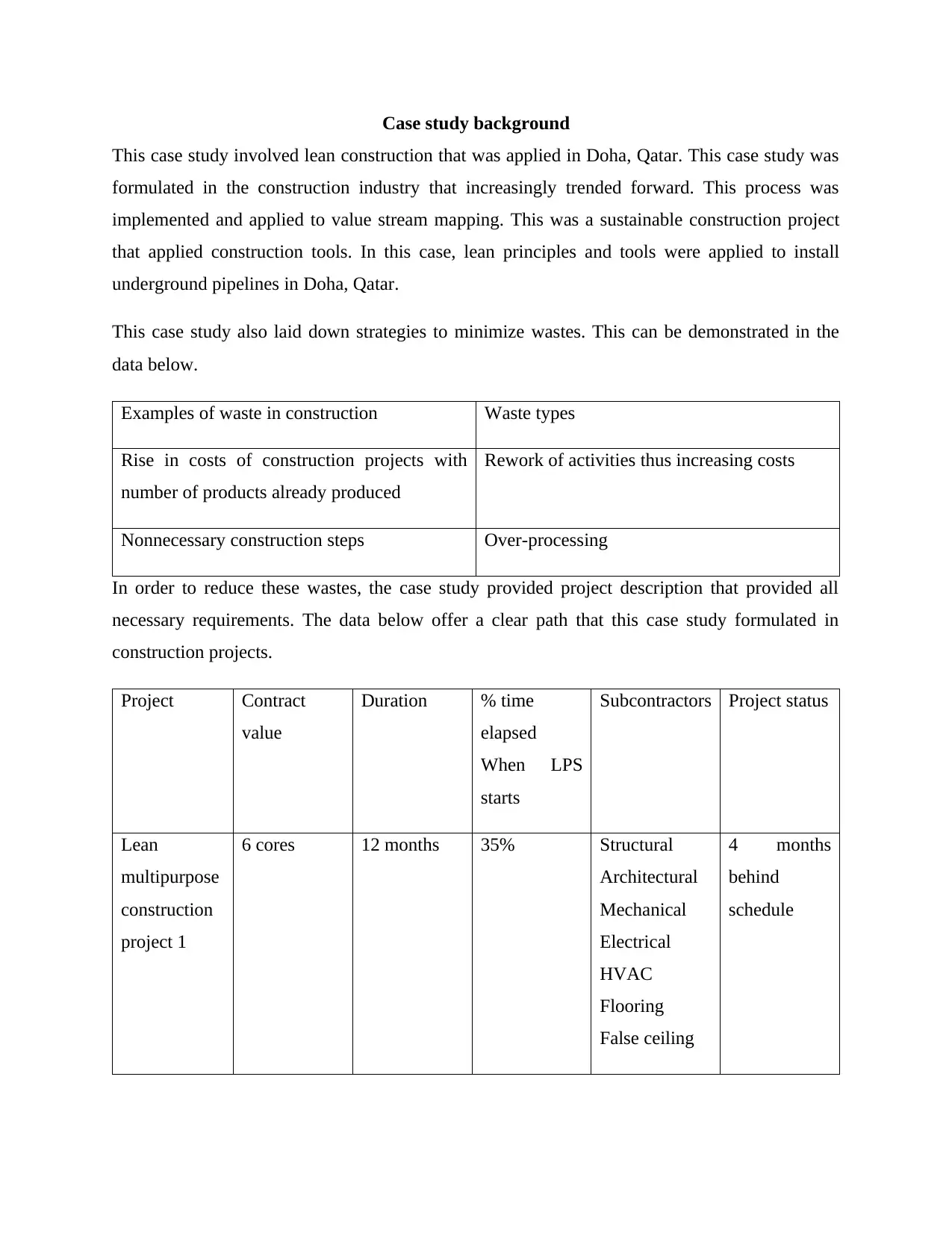
Case study background
This case study involved lean construction that was applied in Doha, Qatar. This case study was
formulated in the construction industry that increasingly trended forward. This process was
implemented and applied to value stream mapping. This was a sustainable construction project
that applied construction tools. In this case, lean principles and tools were applied to install
underground pipelines in Doha, Qatar.
This case study also laid down strategies to minimize wastes. This can be demonstrated in the
data below.
Examples of waste in construction Waste types
Rise in costs of construction projects with
number of products already produced
Rework of activities thus increasing costs
Nonnecessary construction steps Over-processing
In order to reduce these wastes, the case study provided project description that provided all
necessary requirements. The data below offer a clear path that this case study formulated in
construction projects.
Project Contract
value
Duration % time
elapsed
When LPS
starts
Subcontractors Project status
Lean
multipurpose
construction
project 1
6 cores 12 months 35% Structural
Architectural
Mechanical
Electrical
HVAC
Flooring
False ceiling
4 months
behind
schedule
This case study involved lean construction that was applied in Doha, Qatar. This case study was
formulated in the construction industry that increasingly trended forward. This process was
implemented and applied to value stream mapping. This was a sustainable construction project
that applied construction tools. In this case, lean principles and tools were applied to install
underground pipelines in Doha, Qatar.
This case study also laid down strategies to minimize wastes. This can be demonstrated in the
data below.
Examples of waste in construction Waste types
Rise in costs of construction projects with
number of products already produced
Rework of activities thus increasing costs
Nonnecessary construction steps Over-processing
In order to reduce these wastes, the case study provided project description that provided all
necessary requirements. The data below offer a clear path that this case study formulated in
construction projects.
Project Contract
value
Duration % time
elapsed
When LPS
starts
Subcontractors Project status
Lean
multipurpose
construction
project 1
6 cores 12 months 35% Structural
Architectural
Mechanical
Electrical
HVAC
Flooring
False ceiling
4 months
behind
schedule
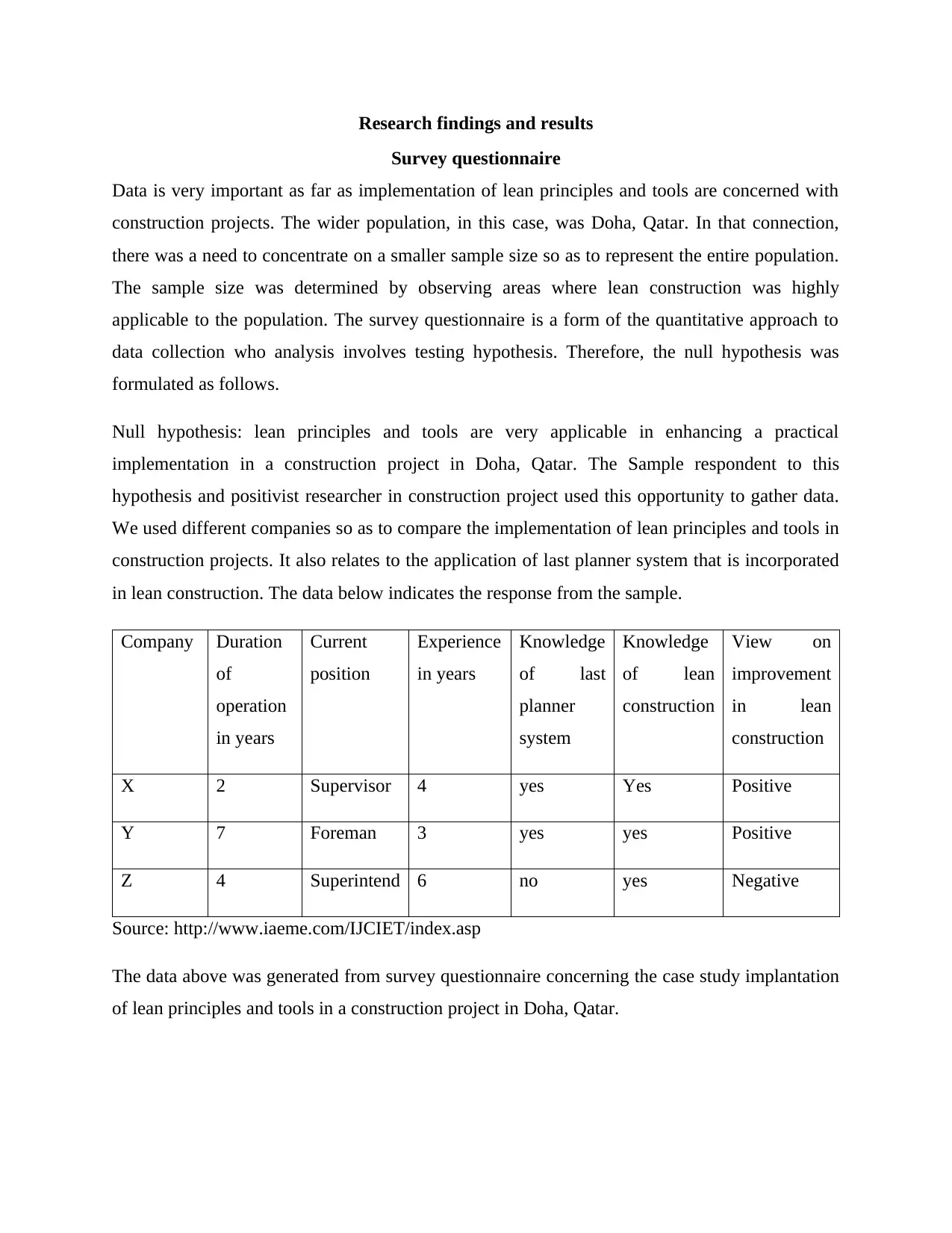
Research findings and results
Survey questionnaire
Data is very important as far as implementation of lean principles and tools are concerned with
construction projects. The wider population, in this case, was Doha, Qatar. In that connection,
there was a need to concentrate on a smaller sample size so as to represent the entire population.
The sample size was determined by observing areas where lean construction was highly
applicable to the population. The survey questionnaire is a form of the quantitative approach to
data collection who analysis involves testing hypothesis. Therefore, the null hypothesis was
formulated as follows.
Null hypothesis: lean principles and tools are very applicable in enhancing a practical
implementation in a construction project in Doha, Qatar. The Sample respondent to this
hypothesis and positivist researcher in construction project used this opportunity to gather data.
We used different companies so as to compare the implementation of lean principles and tools in
construction projects. It also relates to the application of last planner system that is incorporated
in lean construction. The data below indicates the response from the sample.
Company Duration
of
operation
in years
Current
position
Experience
in years
Knowledge
of last
planner
system
Knowledge
of lean
construction
View on
improvement
in lean
construction
X 2 Supervisor 4 yes Yes Positive
Y 7 Foreman 3 yes yes Positive
Z 4 Superintend 6 no yes Negative
Source: http://www.iaeme.com/IJCIET/index.asp
The data above was generated from survey questionnaire concerning the case study implantation
of lean principles and tools in a construction project in Doha, Qatar.
Survey questionnaire
Data is very important as far as implementation of lean principles and tools are concerned with
construction projects. The wider population, in this case, was Doha, Qatar. In that connection,
there was a need to concentrate on a smaller sample size so as to represent the entire population.
The sample size was determined by observing areas where lean construction was highly
applicable to the population. The survey questionnaire is a form of the quantitative approach to
data collection who analysis involves testing hypothesis. Therefore, the null hypothesis was
formulated as follows.
Null hypothesis: lean principles and tools are very applicable in enhancing a practical
implementation in a construction project in Doha, Qatar. The Sample respondent to this
hypothesis and positivist researcher in construction project used this opportunity to gather data.
We used different companies so as to compare the implementation of lean principles and tools in
construction projects. It also relates to the application of last planner system that is incorporated
in lean construction. The data below indicates the response from the sample.
Company Duration
of
operation
in years
Current
position
Experience
in years
Knowledge
of last
planner
system
Knowledge
of lean
construction
View on
improvement
in lean
construction
X 2 Supervisor 4 yes Yes Positive
Y 7 Foreman 3 yes yes Positive
Z 4 Superintend 6 no yes Negative
Source: http://www.iaeme.com/IJCIET/index.asp
The data above was generated from survey questionnaire concerning the case study implantation
of lean principles and tools in a construction project in Doha, Qatar.
⊘ This is a preview!⊘
Do you want full access?
Subscribe today to unlock all pages.

Trusted by 1+ million students worldwide
1 out of 15
Related Documents
Your All-in-One AI-Powered Toolkit for Academic Success.
+13062052269
info@desklib.com
Available 24*7 on WhatsApp / Email
![[object Object]](/_next/static/media/star-bottom.7253800d.svg)
Unlock your academic potential
Copyright © 2020–2025 A2Z Services. All Rights Reserved. Developed and managed by ZUCOL.





